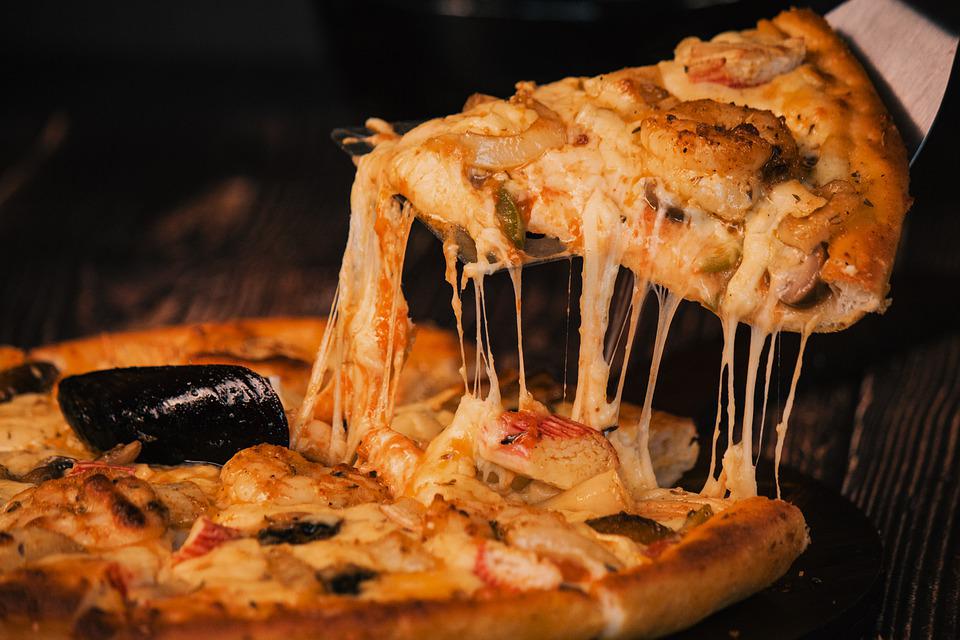There’s simply no such thing as a pizza without cheese. With everything else, you can go the route of availability or exclusion. It doesn’t work that way with cheese. Tender mozzarella, brutal parmesan, blue cheese with a twist, fusible gouda, fragrant goat cheese – all together they make pizza the most beloved dish in the world. Sanctions have only separated us from homemade pizza for a while: now you can make an authentic Italian dish with Russian cheeses. But the recommended cheese set, however, is not canceled. We talked to an expert from Italy and he counted 7 basic cheeses for a tasty homemade pizza.
What cheeses you can use at home to make pizza
Mozzarella cheese for pizza
Dense mozzarella is the staple cheese for pizza. It’s easy to recognise on the shelf – it’s sold without brine, in one big ‘head’. But don’t worry if you can’t find it. Mozzarella, which is sold in plastic bags with brine, also works. It melts a little differently, but it has an active milk flavor and a very delicate taste. The main thing you should know is not to splurge on cheap mozzarella substitutes, you won’t need that much. But the quality of mozzarella, like any other cheese, determines the final result. Another point – of all the cheeses used for pizza, mozzarella is the least savory.
Here’s what Marcello Stozzi, chef from Rome, says: “I believe that if the pizza has tomato sauce, only pure mozzarella or mixed with its close relative, the hard, fat-free provolone cheese is definitely suitable for it. Blue cheese, in this case, has to be used very carefully. These products have too different tastes: the tomato gives the sweetness and sourness, while the blue mold gives the tanginess and spiciness. I don’t like 4-cheese pizza made with a tomato base at all.
Provolone cheese for pizza
Marcello Stozzi, a chef in Rome, recommends using both mozzarella and provolone, a hard, low-fat, soft-crust cow’s milk cheese, to make pizza. The less aged the provolone, the sweeter the pizza will taste. It is said that such cheese produced by Russian cheese dairies can also be found in our country. But the analogue of provolone in Russia, can be any low-fat cow cheese. Especially good pizza smoked cow cheese, such as provolone.
The name provolone comes from “provola”, which means “ball-shaped”. It is usually circular in shape, although you can find cheese that looks like a pear or a sausage pulled with twine. Provolone, having a fibrous texture, like mozzarella, belongs to the category of ‘drawn-out’ cheeses.”
Gouda and maasdam cheese for pizza
Gouda and maasdam melt perfectly. Like mozzarella and provolone, they make an excellent base for pizza.
Cheddar cheese for pizza
Marcello Stozzi, chef from Rome: “Cheddar cheese is not used in a classic pizza recipe. But, if you’re not looking to cook exactly according to Italian canons, cheddar is fine. It has a spicy, recognisable flavour and works well on a chicken or minced meat American-style pizza on ‘puffy’ dough.
Ricotta cheese for pizza
Ricotta is sometimes used for ‘4 cheese’ pizzas when cooked as it should be with a white sauce – a variation of the béchamel sauce (see recipe below). It can be accompanied by mozzarella, emmental and blue cheese. Or you can make another pizza – just with ricotta and white sauce, adding cooked ham, prawns or pieces of chicken, preferably smoked chicken.
Parmesan cheese for pizza
Marcello Stozzi, chef from Rome: “Parmesan is a decoration, not a base. It provides the finishing touches of flavor to the pizza. Italians often don’t melt it, but grate it and sprinkle it on the pizza after it comes out of the oven.
The white 4-cheese pizza sauce mentioned above is made with milk, garlic, parmesan cheese, salt and freshly ground pepper.
This recipe makes about 300 ml of white sauce in 5-7 minutes, which is enough for 4 pizzas 25 cm in diameter.
Melt 40g butter in a saucepan over a medium heat. Add 2 tbsp flour and stir for 1-2 minutes or until browned.
Thinly add 210-220 ml of milk with 2% or more fat. Do not stop stirring until the mixture thickens and becomes homogeneous without lumps. Season with salt and pepper and add 1-2 cloves of garlic, crushed through a press.
Add 30-40g of coarsely grated Parmesan, stirring continuously for about 30 seconds. Remove from the heat and stir until the cheese is completely melted.
Goat cheese for pizza
Marcello Stozzi, chef from Rome: ‘Soft goat cheese doesn’t like high temperatures. It just needs to be crumbled and sprinkled over hot pizza before serving. Goes well with caramelized onions and freshly ground black pepper.

